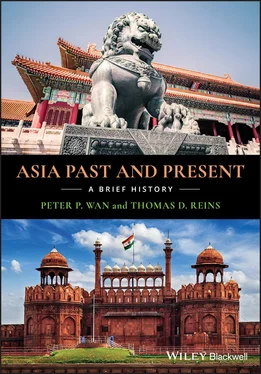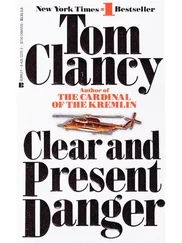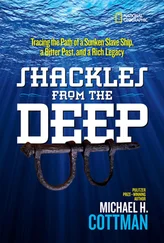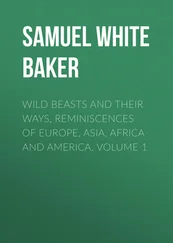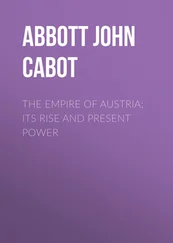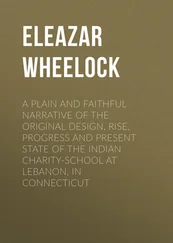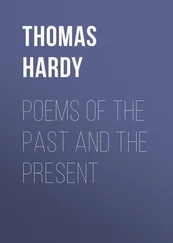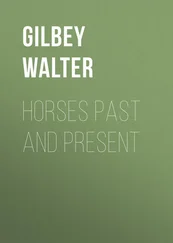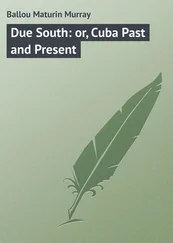Wang Zhen (1271–1368), a Yuan government official, published his Book on Farming , which consists of 22 volumes and contains 306 illustrations (1313). It is an encyclopedic work that describes China’s agricultural practices and equipment up to his day. Its sections on new techniques and mechanical devices for growing cotton and making cotton cloth are the most fascinating.
The Mongols had always taken a keen interest in artisans and manufacture. Whenever they captured a city, they would round up the artisans and carry them off as prisoners. Artisans enjoyed certain privileges: They were given stipends and issued rations, and they were exempt from taxes and labor service. But they were also deprived of personal freedom: The law required their sons to carry on their trade and their daughters to do embroidery. Government‐run artisan industries became highly developed under centralized government control and support. Their war artisans produced excellent tubular copper cannon, and their civil artisans produced exquisite carpets.
The Mongol government played an active role in economic activities. It freely used its coercive powers to achieve economic benefits for itself at the expense of the normal functioning of economic forces. It directly managed monopolies of gold, silver, copper, iron, and salt. It sold monopoly rights and licenses to merchants to trade in everything from tea, liquor, farm tools, bamboo, and timber to aluminum and zinc. It also sold licenses to Muslims to act as government agents −tax farming− to collect taxes. This system had a serious built‐in flaw: Since the agents paid a fixed fee for the privilege of being tax collectors, they would stop at nothing to extract the last drop of blood from the peasants. The increased tax burden on the peasants would eventually force them into rebellion.
Mongols in high places often had the dual role of high government official and big merchant. They hired Muslim financial agents to manage their trading and money‐lending businesses. And the Muslim agents often used their privileged position to violate normal business practices, and cause serious disruptions to the normal operation of the economy.
The cotton revolution that took place in the Yuan Dynasty brought about profound changes in China’s economy. The cotton plant is native to India; it was first introduced into China in its southern frontier regions, then gradually spread across the country. It found the two essential elements it needed to thrive along the Lower Yangtze River: a favorable natural environment and an abundance of manpower. The Lower Yangtze had been a rice‐growing region, but since cotton yielded better returns, it soon overtook rice to become the main crop. The growing of cotton, along with the manufacture and trading of cotton textiles, became the major source of income for many farming families there. This changed the nature of agriculture in the Yangtze Delta: Commercial agriculture was replacing subsistence agriculture, and thriving.
Huang Daopo(1245?–1330) was a catalyst of the cotton revolution. She was a native of Songjiang (near modern Shanghai). Fleeing from domestic abuse, she snuck aboard an oceangoing ship as a stowaway, and arrived at Hainan Island off the South China coast. There she lived among the native Li people, and learned the techniques of cotton spinning and weaving. When she returned to her native home, cotton growing was already quite widespread, but spinning and weaving technology still lagged behind. She taught the local women what she had learned from the Li people, and improved or invented new machinery for spinning and weaving. Her technology launched the textile industry in her hometown, and made it a center of the cotton textile industry for centuries.
Another big boost was made to the industry when the water‐powered spinning wheel with dozens of spindles appeared during the Yuan Dynasty, four centuries earlier than it did in England.
Trade thrived under Mongol rule. Their far‐flung empire and its well‐developed road system facilitated trade over vast territories. The Silk Road by land was restored and expanded. The Silk Road by sea was expanded to reach from China’s eastern coast to the Persian Gulf, Africa, and on to the Baltic Sea. China’s exports were silk, tea, and porcelain. Imports included gold, copper, spices, jewelry, and ivory.
The government expanded the role of paper currency to meet the demand of the ever‐growing volume of trade. The paper money was first put on a silk standard, and later on a silver standard. But the government was unable to restrain its appetite for printing ever more paper money without valuable reserves to back it up. In late Yuan, paper money became worthless, and inflation spun out of control.
The Yuan capital Dadu was much farther north than earlier Chinese capitals, while the country’s economic center had completed its shift to the South. Much of the government’s revenue came in the form of rice, silk, and cotton cloth, which were all produced in the South and had to be shipped north by sea. This practice continued even after the Grand Canal was restored and extended to Dadu.
The Yuan government adopted a policy of religious tolerance to bring the many races, nations, and cultures under one big tent. The Mongols themselves embraced Shamanism and Lamaism (a Tibetan branch of Buddhism). As they advanced westward, the religions of occupied regions were backfilled into China. In their capital Dadu, many religions coexisted and thrived, including Islam, Christianity, and Judaism. There were large numbers of Muslims from Central Asia, Catholics from Europe, and 30,000 Protestant Christians. The Yuan emperors exchanged letters with the pope of the Roman Catholic Church and the king of France, and met with their emissaries.
Muslim scientists were at the forefront of science and technology. Their influence reverberated both westward into Europe and eastward into China. Jamā al‐Din (? –1290) was a Persian astronomer and calendar maker in Kublai Khan’s court, and brought the best of Arab astronomy to China. He developed the Muslim calendar and erected seven Arab astronomical instruments in Dadu. Guo Shoujing (1231–1316) was a Chinese mathematician, astronomer, and calendar maker who also served at the imperial court. He made a calendar in 1280 that specified that one tropical year contained 365.2425 days. This measurement is only off by 26 seconds, the same as that of the Gregorian calendar, which was issued three centuries later and is still in use today. Guo’s achievement clearly benefitted from Jamā al‐Din’s accomplishments.
The Yuan government made a few gestures at restoring the status of Confucianism and the imperial examination system. But they were sporadic and halfhearted, just like its attempts at reforming the land system. As a result, large numbers of educated Han Chinese scholars were left outside the system with a social status somewhere between beggars and whores. As outcasts of the establishment, some of them turned their talents to literary endeavor. They developed a new poetic genre, the Qu, which is a highly sophisticated form of poetic drama that combines a plebeian Han Chinese vocabulary with a heavy dose of non‐Han musical influences. Its versatility made it a popular vehicle for the expression of the emotions of the common people, which often gave away a rebellious spirit against the social evils of the day. It was antiestablishment and subversive to Mongol rule. The poetic genres of Yuan Qu, along with Tang Shi and Song Ci, are among China’s most cherished literary heritages.
Other educated Han Chinese rejected by the Mongol establishment easily gravitated to rebel forces toward the end of the Yuan Dynasty. Late Yuan government was corrupt and incompetent to the extreme. Riddled with factional strife and palace intrigue, it had eight emperors in a span of 25 years. Taxes and labor service soared. A rash of rebellions broke out across the country. A major rallying center for rebellions was a secret society—the White Lotus Sect and its military arm known as the Red Turbans. Battered from all sides, the Yuan Mongol regime collapsed. The Yuan Empire lasted less than a hundred years, making it one of the shortest of China’s major dynasties. Its short lifespan was partly due to the fact that the empire was held together by military force with little internal cohesion—it had no common ethnicity, no common culture, and no common economy. It was forged by the sword, and when the sword became blunt and rusted, the empire collapsed and shattered. The numerous territories that were once one single empire returned to their pre‐Mongol state of being many nations and many governments. Although the Mongols conquered China and Korea, their attempts at other Asian conquests (including Japan, Vietnam, Java, and Burma) all ended in abysmal failure.
Читать дальше
